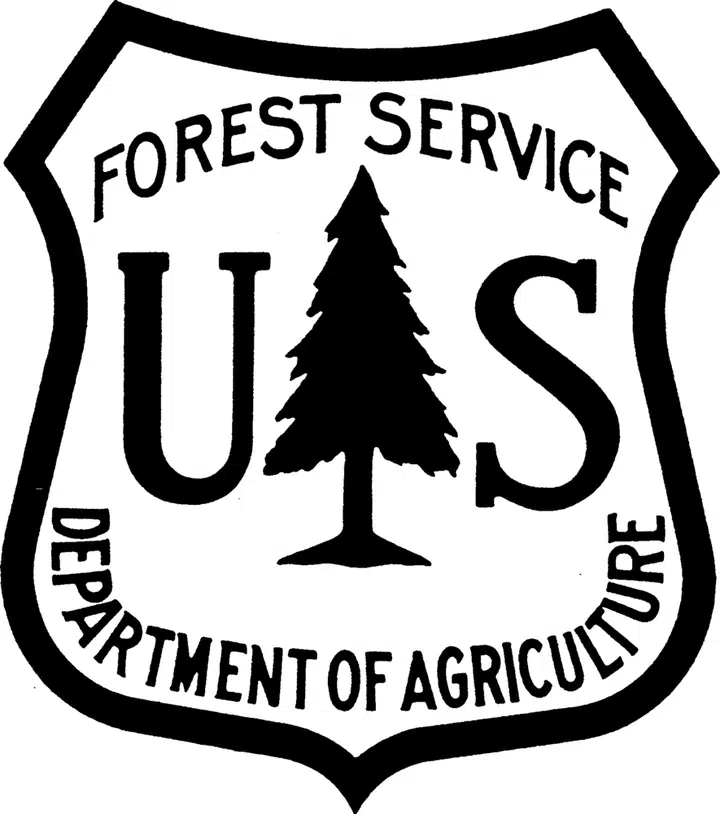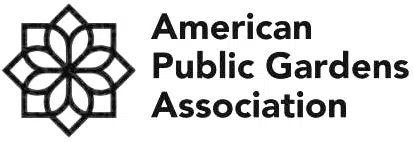Know the Forest Pests That Live in Your Area: Holden Researchers Get the Word Out
November 20, 2025

Do you know what the symptoms of beech leaf disease look like? What about hemlock woolly adelgid — can you tell it from elongate hemlock scale, and did you know these are both insects that can harm trees? If your answers were “no, no, and no,” you’re not alone. Plenty of our neighbors don’t know which tree species are which, let alone what pests and diseases commonly ail them. (Readers of this blog likely score above average on these, though!)
But if you own a yard with trees or a wooded property, it can be a huge help to know how to identify the common forest pests and pathogens that might make your trees sick. Even if you don’t own trees yourself, you can be on the lookout for signs of invasive insects and diseases to help forest health professionals monitor their spread.
That’s why a team of researchers at Holden Forests & Gardens recently embarked on a new project to get the word out. Their mission: to teach more people how to identify our most at-risk native trees and their pests, what to do if you see them, and how to avoid accelerating their spread.
Learn more & get involved:
Visit our new Forest Pests & Diseases page
With federal support from the USDA APHIS, Holden forest health experts, led by research specialist Maris Hollowell and senior research specialist Danny Dlugos, have spent the last few months spreading the word. Here’s what they want you to know about forest pests — and what they’ve been up to.

Common forest pests of the Great Lakes region
There are dozens of forest pests actively spreading throughout our region, but this latest campaign focused on two major culprits: hemlock woolly adelgid and beech leaf disease.
Identifying eastern hemlock trees and hemlock woolly adelgid
Eastern hemlock (Tsuga canadensis) trees are identifiable by their small cones and short, flat needles with a white band on the underside. This slow growing, long-lived tree is native to eastern North America. These trees are threatened by the invasive pest, hemlock woolly adelgid (HWA, Adelges tsugae). During winter months, its adult phase is visible as a small, white, fuzzy insect, feeding on hemlock needles and sapping the tree of its nutrients. Needles will yellow and then drop, eventually killing the tree over a span of years. This pest was introduced to Virginia in the 1950s, and it continues to move west through the Ohio Valley and lower Great Lakes region.

Identifying American beech trees and beech leaf disease
American beech (Fagus grandifolia) is a native tree, identified by its smooth, gray bark and oval leaves with distinct parallel veins and serrated (toothed) edges. They have a unique triangular nut encased in a prickly husk, often eaten by wildlife. Beech leaf disease (BLD) symptoms are caused by a non-native nematode (Litylenchus crenatae ssp. mccannii), a microscopic wormlike animal that enters and feeds on beech buds. This pest was first found in Lake County, Ohio, in 2012 and has since spread to 15 states and into Canada. Researchers at Holden Arboretum have found that approximately 30% of trees in an affected area in Ohio have died; the majority of which are young saplings.
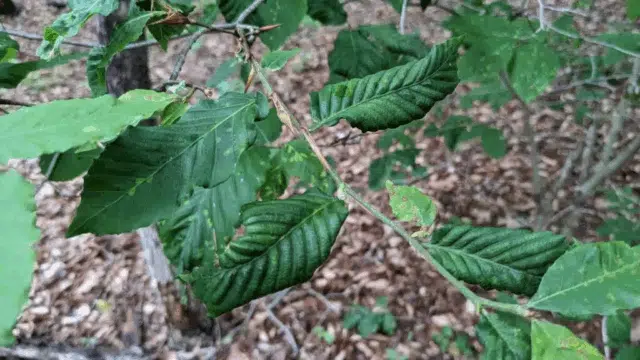
What you can do to help fight HWA and BLD
If you find signs of these pests on your trees, treatments are available. A number of pesticide treatments have been effective against HWA in research trials. For instance, soil drenches of dinotefuran impact HWA rapidly (within 4 weeks), while imidacloprid acts slower (6 months) but provides a more lasting effect. Researchers have found that for BLD, foliar treatments of the fungicide fluopyram, applied in late summer, can reduce nematode numbers by over 90%. Contact a certified tree care specialist in your area if you’d like to treat your trees.
General tree care can also help give affected trees a boost. Trees with BLD or HWA both benefit from increased light and air flow through the canopy. Home pruning should be done in early spring or late fall, taking no more than 30% of the tree canopy per year. Take care when disposing of pruned branches, as relocation of infested limbs can spread the pest. And if you’re planning on planting a new beech or hemlock, be sure to check your new tree for signs of disease before bringing it home.
Finally, members of the public can help track the spread by reporting sightings! Report your observations on EDDmapS.org or iNaturalist to help scientists monitor the progression. For more information on how to help, visit our Forest Pests & Diseases page.
Pulling out all the stops
The Holden team used a number of different approaches to reach as many people as they could with their message. For instance, to reach travelers, they created a brochure with helpful forest pest info — 10,000 brochures have now been shared at events and deployed to seven different rest areas throughout Ohio, Pennsylvania, and Kentucky. Next time you’re traveling, grab one for a friend that needs to learn more about forest pests — or for your kid who loves insects.
“If I had been traveling as a kid and seen a brochure on pests and diseases of plants, I would have run up and grabbed it,” says Dlugos. “That might just be me, but maybe there’s somebody we can inspire with it, and get them interested in science.”
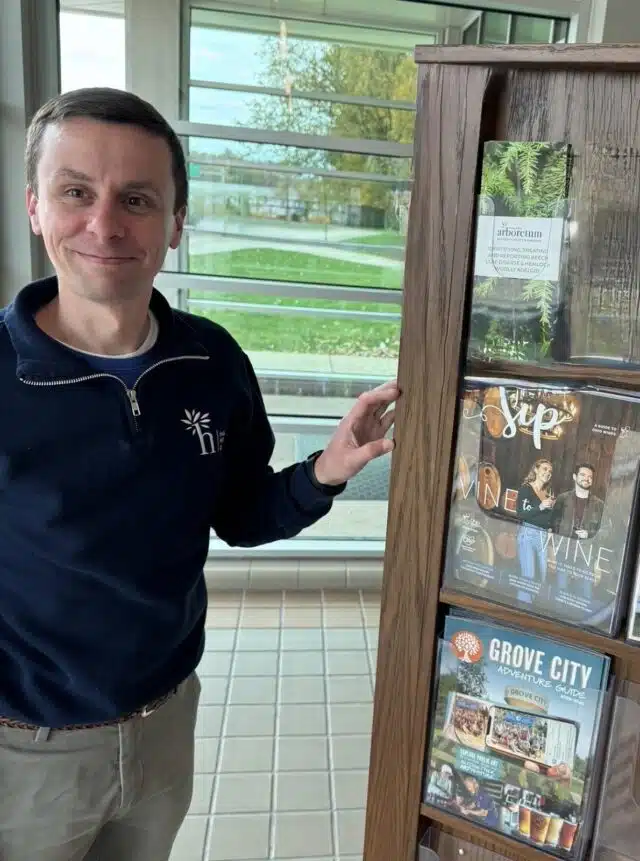
Also part of the effort was a launch of Holden’s new Forest Pests & Diseases webpage, which contains not only the message about HWA and BLD, but descriptions of half a dozen other common forest pests in our region and the trees they affect. As more forest pests and diseases arrive in our area, more will be added to this page along with what you can do to help.
And to reach woodland owners, there’s a new sign, just installed last week, about forest pests and pathogens in the Working Woods Learning Forest at the Arboretum. Over 80% of Ohio’s forest land is privately owned, which means woodland owners have a unique opportunity to make a real difference in monitoring and slowing the spread of these pests.

Spreading the word
Hollowell, Dlugos, and their colleagues have also been busy these past few months spreading their message through in-person and virtual presentations. This September and October, Hollowell and Dlugos presented at the Woodland Cemetery & Arboretum in Dayton, OH, at a meeting of the Civic Garden Center of Greater Cincinnati, and at the Woody Plants & Landscape Symposium in Burlington, KY. Hollowell and research specialist Brianna Shepherd presented to staff at the Knoxville Botanical Garden & Arboretum,
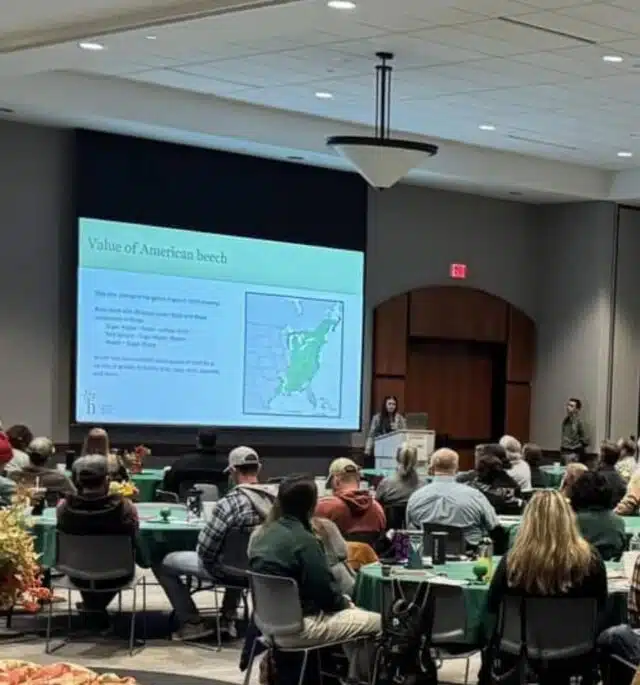
Hollowell, Dlugos, and Shepherd also led a group of almost 80 students at Hawken Lower School in Lyndhurst, OH, to explore their BLD-affected woods. That visit wasn’t just about the pests themselves, they said, it was also an opportunity to get kids interested in science. “It helps for them to encounter people who work in the field to get excited about something — for us to say, this could be your job one day,” says Dlugos.
“I really liked interacting with the students, getting to see them become excited about science and nature, because I’ve always been inspired by science and nature,” says Hollowell.
Team members also shared their message with guests at the Cleveland Botanical Garden and the Holden Arboretum, too (did you catch their booth at the Canopy Walk on October 18?). “A lot of people at the Arboretum were interested,” says Hollowell. “They had either heard of the diseases or had had some run in with them, one way or another.”
“Spotted lanternfly was the one everybody knew — maybe because you can stomp them, and that gets people excited,” says Dlugos. “Our other pests are way more destructive, but people don’t know as much about them.”
And later this week, Shepherd and postdoctoral scientist Rachel Kappler will present to the Western Reserve Land Conservancy in Cleveland. Kappler also recently presented at a Family Nature Day event at Glen Miller Park in Richmond, IN.
A successful effort
“It’s a privilege that we get to work in this field, to see these problems in the forests and study them and help mitigate them,” says Dlugos. “We not only want to share that knowledge, but we also need the public’s help. We can’t go out and scout every forest for BLD, and we need help monitoring the spread.”
“I couldn’t be happier with how this all went, and with the dedication Maris especially put into it,” says Dlugos. “It was a lot of work and coordination, but it was worth it.”
Want to learn more about protecting your trees? Visit our Forest Pests & Diseases page to identify trees and common threats, find treatment options, and discover how you can help monitor forest health in our region.

Anna Funk, PhD
Science Communications Specialist
Anna Funk is the Science Communication Specialist for Holden Forests & Gardens. She earned her Ph.D. studying prairie restoration before leaving the research world to help tell scientists’ stories. Today, she wears many hats, working as a writer, editor, journalist and more — anything that lets her share her appreciation of science and its impact with others.










